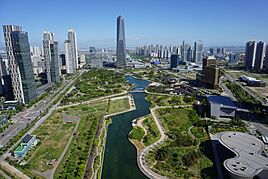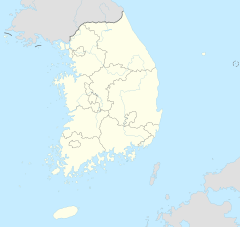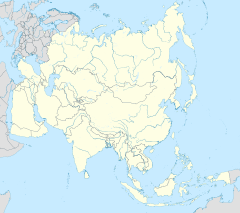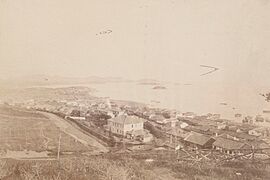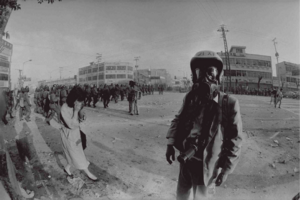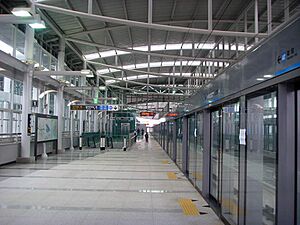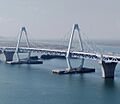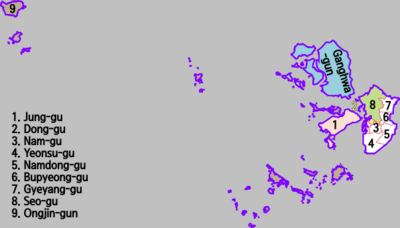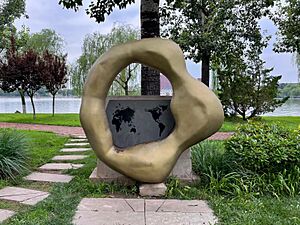Incheon facts for kids
Quick facts for kids
Incheon
인천시
仁川市 |
|||
|---|---|---|---|
|
Metropolitan city
|
|||
| Incheon Metropolitan City 인천광역시 仁川廣域市 |
|||
| Korean name transcription(s) | |||
| • Hangul | 인천광역시 | ||
| • Hanja | 仁川廣域市 | ||
| • Revised Romanization | Incheon Gwangyeoksi | ||
| • McCune-Reischauer | Inch'ŏn Kwangyŏksi | ||
|
Songdo International Business District
Jeondeungsa
Freedom Park
Incheon Bridge
Incheon Football Stadium
|
|||
|
|||
| Anthem: Song of Incheon | |||
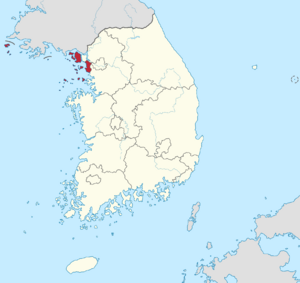 |
|||
| Country | South Korea | ||
| Region | Seoul Capital | ||
| Subdivisions |
List
8 districts ("gu")
Jung-gu (중구; 中區) Michuhol-gu (미추홀구; 彌鄒忽區) Namdong-gu (남동구; 南洞구) Seo-gu (서구; 西區) Yeonsu-gu (연수구; 延壽區) 2 counties ("gun") Ganghwa-gun (강화군; 江華郡) Ongjin-gun (옹진군; 甕津郡) |
||
| Government | |||
| • Type | Mayor-Council | ||
| Area | |||
| • Total | 1,062.63 km2 (410.28 sq mi) | ||
| Population
(October, 2022)
|
|||
| • Total | 2,962,388 | ||
| • Density | 2,787.789/km2 (7,220.34/sq mi) | ||
| GDP | |||
| • Total | KR₩ 104 trillion US$ 83 billion (2022) |
||
| Time zone | UTC+9 (Korea Standard Time) | ||
| Area code(s) | +82-31 | ||
| Dialect | Gyeonggi | ||
| Flower | Rose | ||
| Tree | Tulip tree | ||
| Bird | Crane | ||
Incheon is a big city in northwestern South Korea. It is close to Seoul and Gyeonggi Province. The city's name means "kind river."
People have lived in Incheon since ancient times, even before the Neolithic period. In 1883, it became an international port. At that time, only about 4,700 people lived there.
Today, Incheon is home to about 3 million people. This makes it South Korea's third-largest city. Only Seoul and Busan have more people.
Incheon's port has helped the city grow a lot. Its location near the capital, Seoul, is also a big advantage. Incheon is part of the Seoul Capital Area. This area is one of the world's largest metropolitan areas.
Incheon has played a key role in South Korea's economic growth. It opened its port to other countries, helping the country modernize. In 2003, Incheon became South Korea's first free economic zone. This means it's a special area where businesses can invest more easily. Big companies like Samsung have invested here.
As an international city, Incheon has hosted many large events. These include the Incheon Global Fair & Festival in 2009. The 17th Asian Games were also held here in 2014. Incheon is also a major travel hub in Northeast Asia. It has Incheon International Airport and a very busy port.
Contents
- History of Incheon
- Education in Incheon
- Climate in Incheon
- Economy of Incheon
- Transportation in Incheon
- Incheon Free Economic Zone
- Administrative Divisions of Incheon
- Population and Religion in Incheon
- Sports in Incheon
- Places to Visit in Incheon
- Images for kids
- Notable People from Incheon
- International Friends of Incheon
- See also
History of Incheon
The first records of Incheon are from 475 CE. Back then, it was called Michuhol. This name was used during the time of King Jangsu of Goguryeo. The area changed names many times over the years.
During the Goryeo era, it was known as Gyeongwon or Inju. The name Incheon was first used in 1413. Later, Incheon became a larger administrative area. Old Incheon included parts of today's southern Incheon and northern Siheung City. The main city area was Gwangyo-dong.
Modern History of Incheon
Another old name for the city is Jemulpo. This name became popular when the port opened in 1883. It was used often until Japan took control of Korea. After the port opened, the city's main area moved to Jemulpo. Today, both Jemulpo and Gwangyo-dong are seen as the "Original Incheon."
When Japan ruled Korea, Incheon was called Jinsen. This was based on the Japanese way of saying Incheon's name. In 1914, the Japanese government changed the city's borders. Some parts of old Incheon were combined with other areas. Later, some of these parts were added back to Incheon City.
Incheon used to be part of Gyeonggi Province. But on July 1, 1981, it became a "Directly Governed City." This meant it was separate from the province. More areas and islands were added to Incheon in 1989 and 1995. Before 2000, the city's name was often spelled Inchon in English.
Major Events in Incheon
Incheon was the site of the Battle of Chemulpo Bay. This is where the first shots of the Russo-Japanese War were fired.
During the Korean War, North Korean troops took over Incheon on July 4, 1950. Later, the Battle of Inchon took place here. United States troops landed to help the United Nations forces. This battle was a big victory for the UN. Incheon was taken back on September 19, 1950. The ship USS Inchon was named after this important battle.
Incheon also saw many protests for democracy in 1987. This was before and during the June Democratic Movement.
The city has hosted many big international events. The Global Fair & Festival 2009 Incheon was held in the Songdo District. It lasted for 80 days. Many global groups and companies took part. Musicians and artists also performed.
Incheon hosted a meeting of the G20 Finance Ministers in 2010. It also held the third Global Model United Nations Conference in 2011. The city has hosted the Incheon Women Artists' Biennale several times.
Incheon hosted the Asian Games in 2014. It also hosted the 6th OECD World Forum in 2018. In 2015, UNESCO named Incheon the World Book Capital.
Education in Incheon
On February 27, 2007, Incheon started a program called "Incheon Free English Zone." The goal was to make the city very good at English. This helps Incheon become a major business center in Northeast Asia. The program's slogan is "Smile with English."
Universities and Colleges in Incheon
Incheon has many colleges and universities, including:
- George Mason University Korea Campus
- Ghent University Global Campus
- Gyeongin National University of Education Incheon campus
- Inha University
- Gachon University Medical·Ganghwa campus
- Gyeongin Women's College
- Inha Technical College
- Incheon Catholic University
- Incheon City College
- Incheon National University
- Jaineung College
- University of Utah Asia Campus
- SUNY South Korea
- Anyang University Ganghwa campus
- Yonsei University International campus
- Korea Polytechnics II
- Seongsan Hyo University
- Juan International University
Climate in Incheon
Incheon has a climate with four clear seasons. The temperature changes throughout the year, but it is usually mild. In winter, cold winds from the northwest blow into the city. In summer, warm winds from the southwest arrive.
Incheon's climate is similar to other parts of Korea. It has a mix of humid subtropical and humid continental weather. Like other big cities, Incheon can be warmer in the city center due to buildings and roads.
| Climate data for Incheon (1991–2020 normals, extremes 1904–present) | |||||||||||||
|---|---|---|---|---|---|---|---|---|---|---|---|---|---|
| Month | Jan | Feb | Mar | Apr | May | Jun | Jul | Aug | Sep | Oct | Nov | Dec | Year |
| Record high °C (°F) | 15.8 (60.4) |
18.2 (64.8) |
21.9 (71.4) |
32.7 (90.9) |
31.2 (88.2) |
33.8 (92.8) |
38.9 (102.0) |
38.9 (102.0) |
33.4 (92.1) |
28.6 (83.5) |
26.2 (79.2) |
17.5 (63.5) |
38.9 (102.0) |
| Mean daily maximum °C (°F) | 2.2 (36.0) |
4.8 (40.6) |
10.1 (50.2) |
16.2 (61.2) |
21.6 (70.9) |
25.6 (78.1) |
27.8 (82.0) |
29.2 (84.6) |
25.8 (78.4) |
19.9 (67.8) |
12.0 (53.6) |
4.5 (40.1) |
16.6 (61.9) |
| Daily mean °C (°F) | −1.5 (29.3) |
0.7 (33.3) |
5.6 (42.1) |
11.5 (52.7) |
16.8 (62.2) |
21.3 (70.3) |
24.4 (75.9) |
25.6 (78.1) |
21.5 (70.7) |
15.3 (59.5) |
7.9 (46.2) |
0.7 (33.3) |
12.5 (54.5) |
| Mean daily minimum °C (°F) | −4.8 (23.4) |
−2.8 (27.0) |
2.1 (35.8) |
7.9 (46.2) |
13.1 (55.6) |
18.0 (64.4) |
21.8 (71.2) |
22.9 (73.2) |
18.1 (64.6) |
11.4 (52.5) |
4.3 (39.7) |
−2.7 (27.1) |
9.1 (48.4) |
| Record low °C (°F) | −21.0 (−5.8) |
−18.4 (−1.1) |
−13.8 (7.2) |
−3.6 (25.5) |
3.4 (38.1) |
8.7 (47.7) |
12.8 (55.0) |
14.4 (57.9) |
5.3 (41.5) |
−3.2 (26.2) |
−12.0 (10.4) |
−18.6 (−1.5) |
−21.0 (−5.8) |
| Average precipitation mm (inches) | 15.9 (0.63) |
25.1 (0.99) |
33.8 (1.33) |
63.5 (2.50) |
96.3 (3.79) |
106.0 (4.17) |
337.7 (13.30) |
274.6 (10.81) |
130.3 (5.13) |
51.1 (2.01) |
50.8 (2.00) |
22.3 (0.88) |
1,207.4 (47.54) |
| Average precipitation days (≥ 0.1 mm) | 5.9 | 5.2 | 5.9 | 7.9 | 8.4 | 9.5 | 15.0 | 12.4 | 8.1 | 6.0 | 8.6 | 7.7 | 100.6 |
| Average snowy days | 7.1 | 4.4 | 2.0 | 0.2 | 0.0 | 0.0 | 0.0 | 0.0 | 0.0 | 0.0 | 1.8 | 6.6 | 22.1 |
| Average relative humidity (%) | 61.1 | 61.2 | 63.4 | 64.5 | 69.8 | 75.9 | 83.8 | 80.1 | 72.9 | 66.7 | 64.3 | 61.8 | 68.8 |
| Mean monthly sunshine hours | 186.6 | 188.5 | 215.3 | 220.0 | 239.5 | 212.5 | 159.7 | 189.8 | 200.4 | 219.1 | 170.2 | 176.7 | 2,378.3 |
| Percent possible sunshine | 58.0 | 59.5 | 55.3 | 55.6 | 52.7 | 46.1 | 35.0 | 45.4 | 52.9 | 60.6 | 55.2 | 57.3 | 52.0 |
| Source: Korea Meteorological Administration (percent sunshine 1981–2010) | |||||||||||||
| Climate data for Ganghwa County, Incheon (1991–2020 normals, extremes 1972–present) | |||||||||||||
|---|---|---|---|---|---|---|---|---|---|---|---|---|---|
| Month | Jan | Feb | Mar | Apr | May | Jun | Jul | Aug | Sep | Oct | Nov | Dec | Year |
| Record high °C (°F) | 12.6 (54.7) |
17.4 (63.3) |
22.3 (72.1) |
29.2 (84.6) |
31.0 (87.8) |
33.2 (91.8) |
35.5 (95.9) |
35.8 (96.4) |
31.7 (89.1) |
28.3 (82.9) |
23.8 (74.8) |
16.0 (60.8) |
35.8 (96.4) |
| Mean daily maximum °C (°F) | 1.7 (35.1) |
4.5 (40.1) |
9.8 (49.6) |
16.2 (61.2) |
21.4 (70.5) |
25.4 (77.7) |
27.6 (81.7) |
29.0 (84.2) |
25.5 (77.9) |
19.5 (67.1) |
11.5 (52.7) |
3.9 (39.0) |
16.3 (61.3) |
| Daily mean °C (°F) | −3.2 (26.2) |
−0.7 (30.7) |
4.6 (40.3) |
10.7 (51.3) |
16.0 (60.8) |
20.5 (68.9) |
23.7 (74.7) |
24.7 (76.5) |
20.2 (68.4) |
13.7 (56.7) |
6.3 (43.3) |
−0.9 (30.4) |
11.3 (52.3) |
| Mean daily minimum °C (°F) | −8.1 (17.4) |
−5.8 (21.6) |
−0.6 (30.9) |
5.3 (41.5) |
11.0 (51.8) |
16.3 (61.3) |
20.6 (69.1) |
21.2 (70.2) |
15.6 (60.1) |
8.1 (46.6) |
1.2 (34.2) |
−5.7 (21.7) |
6.6 (43.9) |
| Record low °C (°F) | −22.5 (−8.5) |
−19.4 (−2.9) |
−11.3 (11.7) |
−4.4 (24.1) |
1.6 (34.9) |
6.9 (44.4) |
12.7 (54.9) |
12.5 (54.5) |
3.0 (37.4) |
−4.2 (24.4) |
−12.0 (10.4) |
−19.8 (−3.6) |
−22.5 (−8.5) |
| Average precipitation mm (inches) | 15.6 (0.61) |
22.5 (0.89) |
31.4 (1.24) |
64.9 (2.56) |
110.9 (4.37) |
110.0 (4.33) |
355.6 (14.00) |
300.4 (11.83) |
131.5 (5.18) |
55.8 (2.20) |
46.3 (1.82) |
21.3 (0.84) |
1,266.2 (49.85) |
| Average precipitation days (≥ 0.1 mm) | 5.0 | 4.8 | 6.0 | 7.5 | 8.2 | 8.6 | 14.1 | 11.9 | 7.4 | 5.6 | 7.5 | 6.6 | 93.2 |
| Average snowy days | 7.3 | 4.3 | 2.4 | 0.2 | 0.0 | 0.0 | 0.0 | 0.0 | 0.0 | 0.1 | 1.5 | 5.1 | 20.6 |
| Average relative humidity (%) | 63.6 | 61.0 | 61.4 | 62.4 | 68.6 | 75.1 | 82.8 | 79.9 | 73.8 | 68.9 | 67.8 | 65.4 | 69.2 |
| Mean monthly sunshine hours | 186.2 | 186.5 | 217.0 | 221.7 | 235.3 | 208.5 | 153.0 | 184.9 | 203.8 | 214.3 | 166.0 | 171.8 | 2,349 |
| Percent possible sunshine | 58.7 | 61.8 | 58.9 | 59.0 | 54.8 | 50.0 | 38.6 | 47.7 | 57.4 | 63.3 | 55.7 | 55.6 | 54.6 |
| Source: Korea Meteorological Administration (percent sunshine 1981–2010) | |||||||||||||
| Climate data for Baengnyeongdo, Ongjin County, Incheon (2001–2020 normals, extremes 2000–present) | |||||||||||||
|---|---|---|---|---|---|---|---|---|---|---|---|---|---|
| Month | Jan | Feb | Mar | Apr | May | Jun | Jul | Aug | Sep | Oct | Nov | Dec | Year |
| Record high °C (°F) | 9.4 (48.9) |
15.5 (59.9) |
17.3 (63.1) |
23.7 (74.7) |
28.1 (82.6) |
30.0 (86.0) |
33.5 (92.3) |
33.2 (91.8) |
29.9 (85.8) |
25.6 (78.1) |
20.3 (68.5) |
13.8 (56.8) |
33.5 (92.3) |
| Mean daily maximum °C (°F) | 1.2 (34.2) |
2.8 (37.0) |
7.1 (44.8) |
13.0 (55.4) |
18.7 (65.7) |
22.9 (73.2) |
25.4 (77.7) |
26.9 (80.4) |
23.5 (74.3) |
17.7 (63.9) |
10.6 (51.1) |
3.8 (38.8) |
14.5 (58.1) |
| Daily mean °C (°F) | −1.3 (29.7) |
0.0 (32.0) |
3.8 (38.8) |
9.1 (48.4) |
14.5 (58.1) |
19.0 (66.2) |
22.3 (72.1) |
23.8 (74.8) |
20.1 (68.2) |
14.7 (58.5) |
7.9 (46.2) |
1.2 (34.2) |
11.3 (52.3) |
| Mean daily minimum °C (°F) | −3.4 (25.9) |
−2.2 (28.0) |
1.3 (34.3) |
6.0 (42.8) |
11.1 (52.0) |
16.1 (61.0) |
19.9 (67.8) |
21.5 (70.7) |
17.8 (64.0) |
12.3 (54.1) |
5.5 (41.9) |
−1.1 (30.0) |
8.7 (47.7) |
| Record low °C (°F) | −17.4 (0.7) |
−15.3 (4.5) |
−7.7 (18.1) |
0.5 (32.9) |
5.0 (41.0) |
7.3 (45.1) |
13.0 (55.4) |
14.1 (57.4) |
10.7 (51.3) |
2.1 (35.8) |
−3.9 (25.0) |
−11.3 (11.7) |
−17.4 (0.7) |
| Average precipitation mm (inches) | 13.3 (0.52) |
17.4 (0.69) |
18.2 (0.72) |
47.5 (1.87) |
74.3 (2.93) |
72.0 (2.83) |
201.0 (7.91) |
158.5 (6.24) |
90.6 (3.57) |
31.0 (1.22) |
41.9 (1.65) |
21.6 (0.85) |
787.3 (31.00) |
| Average precipitation days (≥ 0.1 mm) | 7.4 | 4.8 | 5.3 | 6.9 | 8.1 | 10.0 | 13.9 | 11.1 | 6.7 | 5.0 | 8.5 | 9.9 | 97.6 |
| Average snowy days | 11.0 | 6.2 | 2.3 | 0.1 | 0.0 | 0.0 | 0.0 | 0.0 | 0.0 | 0.2 | 3.0 | 12.7 | 35.5 |
| Average relative humidity (%) | 63.4 | 63.0 | 65.5 | 65.7 | 70.1 | 80.2 | 88.0 | 83.7 | 75.9 | 67.8 | 64.7 | 63.8 | 71.0 |
| Mean monthly sunshine hours | 139.9 | 166.6 | 216.9 | 219.3 | 239.6 | 191.0 | 136.7 | 189.6 | 212.4 | 217.6 | 146.7 | 117.3 | 2,193.6 |
| Percent possible sunshine | 43.3 | 54.3 | 53.9 | 53.0 | 51.4 | 38.6 | 28.6 | 40.8 | 54.5 | 60.6 | 49.3 | 37.9 | 46.8 |
| Source: Korea Meteorological Administration (percent sunshine 1981–2010) | |||||||||||||
Economy of Incheon
Incheon is a key part of Korea's industrial area. For a long time, the city relied on manufacturing. Many factories were built here.
Since 2003, Incheon has been a Free Economic Zone. This means it is trying to grow new industries. One important new industry is the bio industry. Incheon is a major global center for making biological products. It ranks second in the world for this. The city is also growing fast in the logistics industry. This is thanks to Incheon International Airport and the busy Incheon Port.
Transportation in Incheon
Incheon is a very important place for travel in Korea and beyond.
Air Travel in Incheon
Incheon International Airport is South Korea's main international airport. It is also a big airport for all of Asia. In 2015, it was the 22nd busiest airport in the world. Over 49 million passengers used it that year.
In 2015, there were more than 305,000 flights at Incheon Airport. Most of these were international flights. Korea's main airlines, Korean Air and Asiana Airlines, handled about half of these flights. The airport is getting busier every year. A new terminal opened in 2017 to handle more travelers.
The airport was also shown in a Korean TV show called "Air City." In late 2018, Incheon International Airport was ranked as the 5th best international airport in the world.
Sea Travel in Incheon
Incheon's sea port is the second largest port in Korea. Only Busan Port is bigger.
From the International Passenger Terminal, you can take ferries to five cities in China. These cities are Dalian, Qingdao, Tianjin, Dandong, and Weihai. There are also ferries to islands near Incheon. You can even go to Baengnyeong Island.
Bus Travel in Incheon
Incheon Bus Terminal is a major hub for buses. You can take express buses from here to all parts of Korea. Many city bus lines also run within Incheon. They also go to nearby cities like Bucheon, Gimpo, Seoul, and Siheung.
Many buses travel between Seoul and Incheon.
Train Travel in Incheon
Seoul's subway Line 1 offers local train service. It connects Incheon to places like Guro, Seoul, and Uijeongbu. This line has 11 stations in Incheon. You can switch to the Incheon Subway at Bupyeong and Juan stations.
A faster train service on the same line goes to Yongsan station in Seoul. These trains leave from Dongincheon station.
The Airport Express (AREX) line connects Incheon International Airport to Seoul Station. It also stops at Gimpo International Airport. The part between Incheon and Gimpo opened in 2007. It reached Seoul station in 2010. You can choose a fast train that only stops at the airports and Seoul. Or you can take a train that stops at all stations.
KTX high-speed trains also use the AREX line. They started in 2014. KTX trains stop at Incheon International Airport station and Geomam station. There are also plans to bring KTX service to Incheon station by 2021.
Subway in Incheon
The Incheon Subway has two lines. Line 1 connects to the Seoul Metropolitan Subway system at Bupyeong station. It also connects to the AREX line at Gyeyang station. Line 1 runs from International Business District station in Songdo to Gyeyang station. It has 28 stations.
Line 1 also connects to the Suin Line at Woninjae station. You can transfer to Incheon Subway Line 2 at Incheon City Hall station. And you can connect to Seoul Subway Line 7 at Bupyeong-gu Office station.
Incheon Subway Line 2 opened in July 2016. It runs from Geomdan Oryu station to Unyeon station. This line is automated and has 27 stations. It connects to the AREX line at Geomam station. You can also transfer to Seoul Subway Line 1 at Juan station. And you can switch to Incheon Subway Line 2 at Incheon City Hall station.
The Incheon subway is run by the Incheon Rapid Transit Corporation. There are also plans for a third subway line in Incheon.
Korail built a new train line called the Suin Line. It opened in 2012. It connects Oido station in Siheung to Songdo station in Incheon. In 2016, it was extended to Incheon station. Here, you can transfer to Seoul Subway Line 1. In 2020, the line was extended further to Suwon Station.
Seoul Metropolitan Subway Line 7 was extended to Bupyeong-gu office in 2011. This allows transfers to the Incheon Subway. It has 3 stations within Incheon. By 2020, this line will go even further west to Seoknam station. There, you can transfer to Incheon Subway Line 2.
Incheon Free Economic Zone
The Incheon Free Economic Zone (IFEZ) is a special area. It includes Songdo, Cheongna, and Yeongjong Island. Its total size is about 51,739 acres. The goal of IFEZ is to make these areas centers for business, travel, and fun in Northeast Asia.
A "Free Economic Zone" is a special area. It makes it easier for foreign companies to do business. It also makes living conditions better for people from other countries. Incheon's Free Economic Zone was the first in Korea. It was created in August 2003. IFEZ is planned to be a complete city. It will have airports, seaports, business centers, homes, schools, hospitals, and shops.
New Songdo City
Songdo International City started being built in 1994. It is made on land that was reclaimed from the sea. Songdo is designed to be a center for international business and trade. It will also focus on new technologies and eco-friendly living. Construction is expected to finish in 2020.
- Size: 13,162 acres
- Planned population: 252,000 people
- Construction time: 1994 to 2020
Yeongjong Island
As of 2012, Yeongjong International City is being developed. It is centered around the Incheon International Airport. This area is planned to be an eco-friendly airport city. It should be finished by 2020. A South Korean company, Paradise Co, announced in 2013 that it would build Korea's largest casino on Yeongjong Island.
Cheongna District
The Cheongna district is on the mainland next to Yeongjong Island. It will focus on entertainment. It will have a world-class theme park. Cheongna will also be a place to live. It will have sports facilities, flower gardens, and a business area for international finance.
- Size: 4,394 acres
- Planned population: 90,000 people
- Construction time: 2004 to 2008
Administrative Divisions of Incheon
Incheon is divided into 8 districts (called gu) and 2 counties (called gun).
- Bupyeong District (부평구)
- Dong District (동구)
- Gyeyang District (계양구)
- Jung District (중구)
- Michuhol District (미추홀구)
- Namdong District (남동구)
- Seo District (서구)
- Yeonsu District (연수구)
- Ganghwa County (강화군)
- Ongjin County (옹진군)
Population and Religion in Incheon
| Historical population | ||
|---|---|---|
| Year | Pop. | ±% p.a. |
| 1950 | 258,000 | — |
| 1960 | 394,000 | +4.32% |
| 1970 | 627,000 | +4.76% |
| 1980 | 1,062,000 | +5.41% |
| 1990 | 1,785,000 | +5.33% |
| 2000 | 2,371,000 | +2.88% |
| 2010 | 2,559,000 | +0.77% |
| 2019 | 2,938,457 | +1.55% |
| source: | ||
Religion in Incheon (2015) Not religious (57.9%) Protestantism (23.1%) Catholicism (9.5%) Buddhism (8.7%) Other (0.8%)
In 2015, a survey showed the religions of people in Incheon. About 32.6% of people follow Christianity. This includes 23.1% who are Protestant and 9.5% who are Catholic. About 8.7% of the people follow Buddhism.
Most people, 57.9%, said they do not follow any religion. A small number, 0.8%, follow other religions. These include Islam, Muism, and Confucianism.
Sports in Incheon
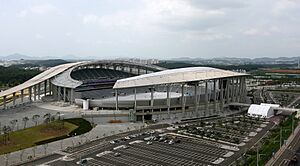
Incheon is home to many professional sports teams:
Football (Soccer):
- The K League 1 team is Incheon United FC.
- The K4 League team is FC Namdong. It is based in the Namdong District.
- The WK League (women's league) team is Hyundai Steel Red Angels.
Baseball:
- The KBO League team is SSG Landers.
- The first professional baseball team from Incheon was the Sammi Superstars.
Basketball:
- The WKBL team is Incheon Shinhan Bank S-Birds.
- From 1997 to 2021, Incheon also had the KBL team Incheon Electroland Elephants.
Volleyball:
- The men's V-League team is Incheon Korean Air Jumbos.
- The women's V-League team is Incheon Heungkuk Life Pink Spiders.
Munhak Sports Complex: The Munhak Sports Complex has two stadiums. One is for football, and the other is for baseball. The football stadium, Munhak Stadium, was used for the 2002 Football World Cup. It is also the home field for Incheon United. The baseball stadium, Munhak Baseball Stadium, is the home field for the SSG Landers.
In April 2007, Incheon was chosen to host the 2014 Asian Games. It won over New Delhi.
Yeonhui Cricket Ground: Yeonhui Cricket Ground is a special stadium for cricket in Incheon. It was built for the cricket events at the 2014 Asian Games. Both men's and women's cricket games were played here. It is the first cricket stadium in South Korea.
Incheon Football Stadium (Sungui Arena): Incheon Football Stadium is the first stadium in Incheon built only for football. It was built in 2012 and can hold 20,891 people.
Places to Visit in Incheon
Incheon also manages several islands to its west. These include Ganghwa Island, Yeongjong Island, and Baengnyeong Island. Baengnyeong Island is the westernmost point of South Korea.
- Bupyeong Station is where Seoul Subway Line 1 and the Incheon subway line meet. There is a large underground shopping center here. It sells clothes and cell phones. Above ground, you can find many restaurants and shops. This shopping center has over 1,400 stores. It was certified as having the most stores in the world in 2014.
- Jayu (Freedom) Park is a park near the city's port. It has a statue of General Douglas MacArthur. There is also a memorial for 100 years of friendship between the U.S. and Korea.
- Chinatown is Korea's only official Chinatown. It is located near Incheon Station and Jayu Park.
- Incheon Bus Terminal is an area around the city's bus terminal. It has a performance venue and a subway station. In this area, called Guwol-dong, there is a busy street called Rodeo Street. It is full of restaurants and department stores.
- Wolmido is an island that was one of the landing spots for MacArthur's invasion. Now, it is a fun place for tourists. It has a boardwalk, an amusement park, and many raw fish restaurants. Ferries go from Wolmido to Yeongjongdo and Jakyakdo.
- Jakyakdo is a small island in the harbor. It is between Wolmido and Yeongjongdo. It has walking paths, picnic spots, a restaurant, and rooms you can rent.
- Incheon Landing Operation Memorial Hall is a museum and plaza. It is dedicated to the Incheon Landing during the Korean War. You can see weapons and items from the war there.
- Incheon Dohobu Cheongsa is the old government building complex for Incheon. It is near Munhak Stadium. This complex has been around since at least 1424 AD.
- Ara Canal is a waterway that connects the Han River to the Yellow Sea. There is a park and a bike path along the canal. Many local people enjoy using it.
- Korean-chinese cultural center was built to help people from Korea and China understand each other better.
- Songwol-dong Fairy Tale Village was created by improving the village. It is now a popular place for young people and children.
- Peking opera wall is located in the heart of Chinatown.
Images for kids
-
The only official Chinatown in South Korea
-
Korean-Chinese cultural center Chinatown in South Korea
-
Songwol-dong Fairy Tale Village in Incheon in South Korea
Notable People from Incheon
- Lee Je-no, member of NCT and NCT Dream
- Miyeon, (G)I-dle
- Hapkido Grand Master Han Bong-soo
- Hangzoo, Rhythm Power
- Kim Ryeo-wook, Super Junior
- Kim Hyo-yeon, Girls' Generation
- Choi Min-ho, Shinee
- Kang Ki-young
- Michaela Dietz, voice actress
- Kim Gu-ra
- Kim Nam-il, footballer
- Cho Yong-hyung, footballer
- Shin Ji, Koyote
- Yoon Chae-kyung, April
- Kang Hye-jung, actress
- Go Kyung-pyo, actor
- Lee Sung-hyun, kickboxer
- Choi Ji-man, baseball player
- Ku Hye-sun, actress
- Hyolyn, Sistar
- Roh Ji-hoon, singer
- Ryu Hyun-jin, baseball player
- Park Cho-a, soloist and former member of AOA
- Bang Min-ah, Girl's Day
- Nam Ji-hyun
- Kyung Soo-jin
- Kim Young-kwang
- JinJoo Lee, DNCE
- Ong Seong-wu, former member of Wanna One, actor and soloist
- Yoo Seung-ho, actor
- Lee Kang-in, footballer
- Kim Sung-joo, singer, actor, UNIQ
- Sung Dong-il, actor
- Sohee, singer and member of Alice
- Park Nam-choon
- Doyeon, singer, actress and member of Weki Meki and WJMK
- Young Kim
- Hong Soo-hyun, actress
- Peggy Gou, DJ
- Kim Won-pil, singer-songwriter, keyboardist and member of Day6
- Do Han-se, rapper and member of Victon
International Friends of Incheon
Incheon has "sister city" relationships with many cities around the world. This means they are friendly partners.
 Alexandria, Egypt (2000)
Alexandria, Egypt (2000) Anchorage, United States (1986)
Anchorage, United States (1986) Banten, Indonesia (2009)
Banten, Indonesia (2009) Burbank, United States (1961)
Burbank, United States (1961) Chongqing, China (2007)
Chongqing, China (2007) Haiphong, Vietnam (1997)
Haiphong, Vietnam (1997) Honolulu, United States (2003)
Honolulu, United States (2003) Kitakyushu, Japan (1988)
Kitakyushu, Japan (1988) Kobe, Japan (2010)
Kobe, Japan (2010) Kolkata, India (2007)
Kolkata, India (2007) Manila, Philippines (2008)
Manila, Philippines (2008) Mérida, Mexico (2007)
Mérida, Mexico (2007) Panama City, Panama (2000)
Panama City, Panama (2000) Philadelphia, United States (1983)
Philadelphia, United States (1983) Phnom Penh, Cambodia (2009)
Phnom Penh, Cambodia (2009) Seattle, United States
Seattle, United States Shenyang, China (2014)
Shenyang, China (2014) Taoyuan, Taiwan (2009)
Taoyuan, Taiwan (2009) Tel Aviv, Israel (2000)
Tel Aviv, Israel (2000) Tianjin, China(1993)
Tianjin, China(1993) Ulaanbaatar, Mongolia (2017)
Ulaanbaatar, Mongolia (2017) Veneto, Italy (2010)
Veneto, Italy (2010) Vladivostok, Russia (2012)
Vladivostok, Russia (2012) Yekaterinburg, Russia (2009)
Yekaterinburg, Russia (2009) Gödöllő, Hungary (2023)
Gödöllő, Hungary (2023)
See also
 In Spanish: Incheon para niños
In Spanish: Incheon para niños


